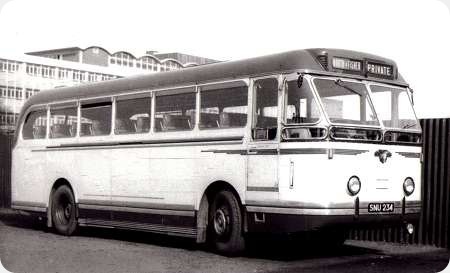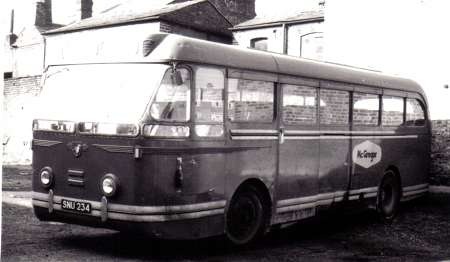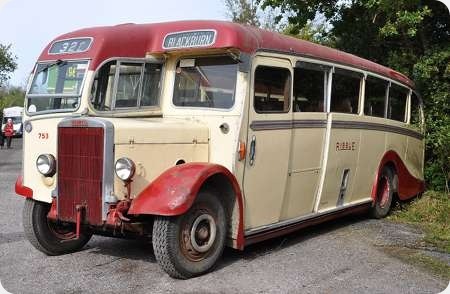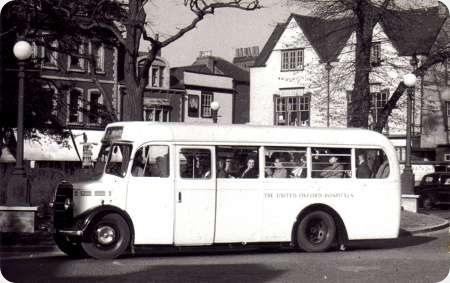Booth & Fisher – Leyland Royal Tiger – SNU 234
Booth & Fisher
1952
Leyland Royal Tiger
Leyland C41C
The first Leylands bought new (in 1952) by this Derbyshire operator were two Royal Tigers; SNU 234 had this C41C body whereas SNU 235 was B44F. Chassis numbers were 520911 and 520179 respectively. School journeys to Creswell swimming baths were often on this superb vehicle, arriving far too soon for me! About seven Leylands had gone before but all were second-hand, and all buses, so this one was special. The coach only stayed until 1963 and was later with McGregor, a contractor. I’m unsure whether or not it served any other operator in-between. SNU 235 lasted until around 1969 but I have been unable to find any photographs of this one.
Photograph and Copy contributed by Les Dickinson
16/02/15 – 06:57
Nice!!! Thanks for posting. I wonder if Oxford Diecast can be persuaded to do a model of this one. I asked a while ago about the possibilities of having one of MTD235, but their reply didn’t leave me very hopeful. Still, the comments from Roger Cox when the Ribble version was issued – wrong shades used – might help them to get further issued right!
Pete Davies
16/02/15 – 06:58
Les, have a look at the posting of Booth and Fisher 612 JPU on this site,
SNU 235 is just visible in the background. I have another slide taken the same day where SNU is in a line of 3 vehicles at the front of the depot
This design of Leyland coach body must have come as quite a shock after many years of coaches with curved waist rails. The later Ribble treatment of the lower front sill enhanced the appearance still further. Note the opening windows, they appear to be of the half(?) drop type and also the semaphore trafficator under the driver’s cab side window. The multi pane windscreen arrangement must have been a recipe for water ingress.
Ian Wild
16/02/15 – 15:47
Here is SNU 234 later in life with McGregor, contractor. Not a great shot but still worth seeing. I bought this five decades ago and photo is not back-stamped so I have no idea of copyright etc.
Les Dickinson
19/02/15 – 07:17
I am pretty sure this coach was with Cherrys of Beverly.
Ken Wragg
14/02/18 – 07:49
Yes Ian Wild you are right, the front faceted windows of the Royal Tiger coach do leak quite a bit and always did from new. I am currently restoring MTD 235 the Leyland demonstrator that was in Pennine’s fleet, it has wind-down windows and semaphore indicators below the cab – it is a very well built all-Leyland coach and a credit to the manufacturer. We have got the mechanics overhauled and am presently well on with refurbishing the interior – I hope the coach will be back on the road before too long. If anyone has any Pennine posters, notices, timetables, photographs and the like relevant to MTD 235 I would be pleased to see them to complete its history.
Phil Clark
14/02/18 – 11:23
Cherry of Beverley was the intermediate owner, SNU 234 was with them from 1963 until the sale to McGregor in 1966.
David Hick
15/02/18 – 06:14
Wonderful news, Phil. I hope to see MTD at the Tram Sunday event in the near future!
Pete Davies
15/02/18 – 06:17
Phil,
Many thanks for your update re Pennine MTD 235, after the sad demise of Pennine Motors I and many others wondered what the fate of this special vehicle would be, after it being in store with Pennine for so long. I know it popped up for sale several times and then lost track of it, so well done for taking on the restoration and good luck with it!! Hope all goes well. I eagerly wait to see MTD 235 back on the road ,at the Pennine running day at some point maybe ?
Mark McAlister
21/02/18 – 07:00
It is very gratifying to know that MTD 235 is undergoing restoration & it will make a fitting tribute to Pennine & Leyland Motors (indeed Pennine was a very loyal Leyland customer).
Does anybody know what has happened to the Plaxton Elite bodied Leopard which came to Pennine when still quite new when Ezra Laycock was taken over in 1972?. Pennine had put this on one side for possible preservation.
Andrew Spriggs
09/04/19 – 08:47
Thanks for the memories regarding the run from Sheffield (Eyre Street stop) to Coal Aston. I used that bus when I was 9 until I was 11 (1959-1961) as I used to travel from my school to our home in Coal Aston on the, then, new Firthwood Estate.
Chris Hunt




